Ecosystems & Biomes Study Island
5.0(1)
5.0(1)
Card Sorting
1/69
Study Analytics
Name | Mastery | Learn | Test | Matching | Spaced |
|---|
No study sessions yet.
70 Terms
1
New cards
The picture above shows part of a savanna ecosystem. Which of the following lists only biotic components of this ecosystem?
elephant, bird, grass
2
New cards

A desert biome is pictured above. Which is a biotic factor that can be found in this biome?
a lizard
3
New cards

Which biome is pictured above?
temperate deciduous forest
4
New cards
Which of the following is the best example of a population?
a school of sunfish
5
New cards
Which of the following is an example of a population?
a large clan of meerkats, including their offspring
6
New cards
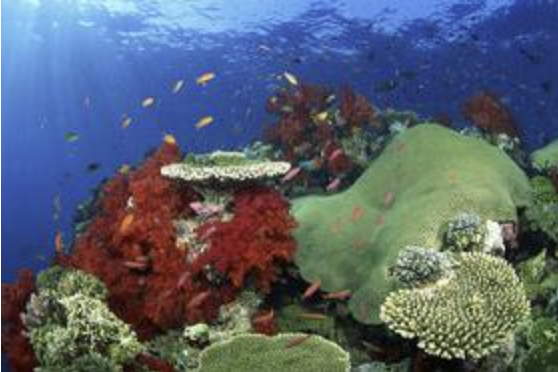
A marine ecosystem is shown below.
\
(photo)
\
Which of the following lists includes only biotic factors that could be found in this ecosystem?
\
(photo)
\
Which of the following lists includes only biotic factors that could be found in this ecosystem?
fish, sea anemones, crustaceans
7
New cards
Permafrost is a layer of permanently frozen soil found in the ______ biome.
tundra
8
New cards
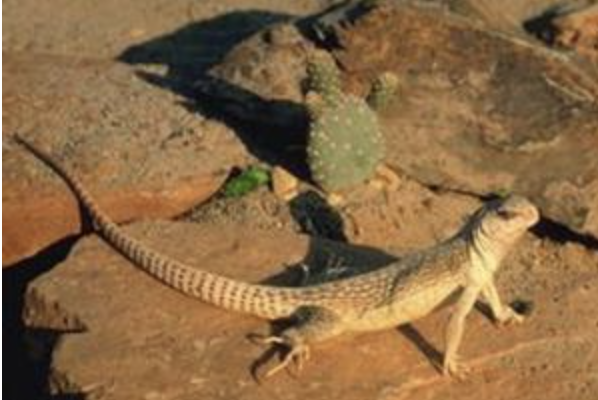
A desert biome is pictured above. Which is an abiotic factor that can be found in this biome?
sand
9
New cards
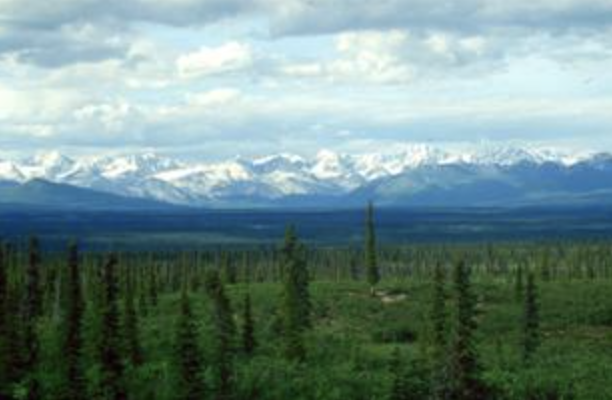
The taiga biome that covers most of Alaska is pictured above. Which of the following only lists biotic factors that can be found in this ecosystem?
moss, aspen trees, weasels, and raccoons
10
New cards
Savanna, tundra, grasslands, and temperate forest are examples of ______.
biomes
11
New cards
All of the living organisms in a forest plus their environment is an example of
an ecosystem
12
New cards
A herd of cattle is an example of
a population
13
New cards
A biome is a broad category of ecological organization that includes all of the biotic and abiotic components of an entire climate region, such as a desert or a rainforest. \n \n Which of the following categories of ecological organization is broader than a biome?
the biosphere
14
New cards
Which of the following shows the organizational level of a biome from the broadest category to the most specific category?
biome → ecosystem → community → population → organism
15
New cards
Hardwood trees, such as oaks, maples, and birches, are most commonly found in _______ biomes.
temperate forest
16
New cards
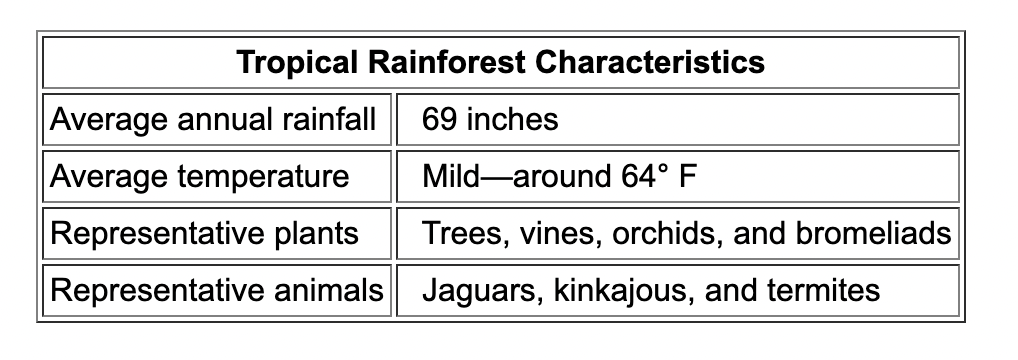
The following table lists characteristics of rainforest biomes.
\
(photo)
\
Abiotic factors found in rainforests include…
\
(photo)
\
Abiotic factors found in rainforests include…
soil, rain, and mild temperatures.
17
New cards
Which of the following best describes an ecosystem?
all the living organisms in an area and their physical surroundings
18
New cards

The levels of organization of the biosphere are shown below, but they are not in the correct order. Arrange the tiles in order of most specific level to broadest level.
organism → population → community → ecosystem → biome

19
New cards
What is the name for the nonliving parts of an ecosystem?
abiotic factors
20
New cards
Which of the following is the best example of a community?
bees and wasps around a group of purple cornflowers
21
New cards
Which choice below lists the biomes in order from lowest average temperatures to highest average temperatures?
taiga, temperate deciduous forest, savanna
22
New cards

The animal species shown above would most likely be found wild in which of the following biomes?
arctic tundra
23
New cards
Succulent plants, such as cacti, are most often found in which terrestrial biome?
desert
24
New cards
Which of the following is the best example of an ecosystem?
a nest of mockingbirds, some bullfrogs, a pond, and a sandy shore
25
New cards
Grasslands are most likely to be described as having
prairies and fertile soil.
26
New cards
A fight between a family of lions and family of hyenas over an animal carcass would be best described as competition between
two different populations
27
New cards
In the _______ biome, the vegetation is so abundant and thick that almost no sunlight reaches the soil.
tropical rainforest
28
New cards
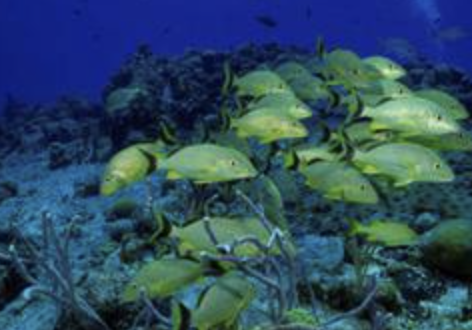
Which of the following are abiotic factors that can be found in the ecosystem pictured? \n
I. ocean currents
II. fish
III. plankton
IV. sand
I. ocean currents
II. fish
III. plankton
IV. sand
I and IV only
29
New cards
A wetland ecosystem is shown below.
\
(photo)
\
Which of the following are abiotic factors of this ecosystem? \n
I. temperature
II. aquatic plants
III. water
IV. sunlight
\
(photo)
\
Which of the following are abiotic factors of this ecosystem? \n
I. temperature
II. aquatic plants
III. water
IV. sunlight
I, III, and IV only
30
New cards
Which biome is characterized by conifers, or trees whose seeds grow in cones?
taiga
31
New cards
A pod of dolphins hunting and feeding on a school of fish is an example of
a community interaction.
32
New cards

A savanna ecosystem is shown below.
\
(photo)
\
_______ is an example of a(n) ________ factor of this ecosystem.
\
(photo)
\
_______ is an example of a(n) ________ factor of this ecosystem.
Sunlight; abiotic
33
New cards
Which choice below lists the biomes in order from lowest precipitation amounts to highest precipitation amounts?
desert, grasslands, temperate deciduous forest, tropical rainforest
34
New cards
Which species list includes animals that would most likely be found in a taiga biome?
lynxes, moose, and pine trees
35
New cards

The environment pictured above is most likely part of a ______ biome.
savannah
36
New cards
The biosphere can best be defined as
any region on Earth where life can exist.
37
New cards
Tropical rainforests are typically found
near the equator
38
New cards
A desert with a hot, dry climate is an example of
a biome
39
New cards
The large, grazing mammals typical of specific _______ biomes known as savannas include elephants, zebras, and giraffes.
grassland
40
New cards
What is the name for the living parts of an ecosystem?
biotic factors
41
New cards

The following table lists characteristics of rainforest biomes.
\
(photo)
\
Biotic factors found in rainforests include…
\
(photo)
\
Biotic factors found in rainforests include…
jaguars, kinkajous, and orchids.
42
New cards
Choose the abiotic factors that characterize the tundra biome.
very low temperatures, very little precipitation
43
New cards

Arrange the levels of ecological organization from smallest to largest.
Organism → ? → ? → Ecosystem
44
New cards
Biotic factors of an ecosystem could include which of the following?
\-all types of plants
\-all animal populations
\-all animal populations
45
New cards
A rodent hibernates to escape the long, cold winter months of this biome. Which biome does the rodent live in?
coniferous forest
46
New cards
Bison are grazers, living in herds that migrate in search of better pasture. Bison live in _____.
grasslands
47
New cards
Tropical rainforests have more kinds of plants and animals than any other land biome. Which of the following is a biotic factor in a tropical rainforest?
a population of decomposers
48
New cards
Which of the following statements is true?
Animals are always biotic components of an ecosystem.
49
New cards
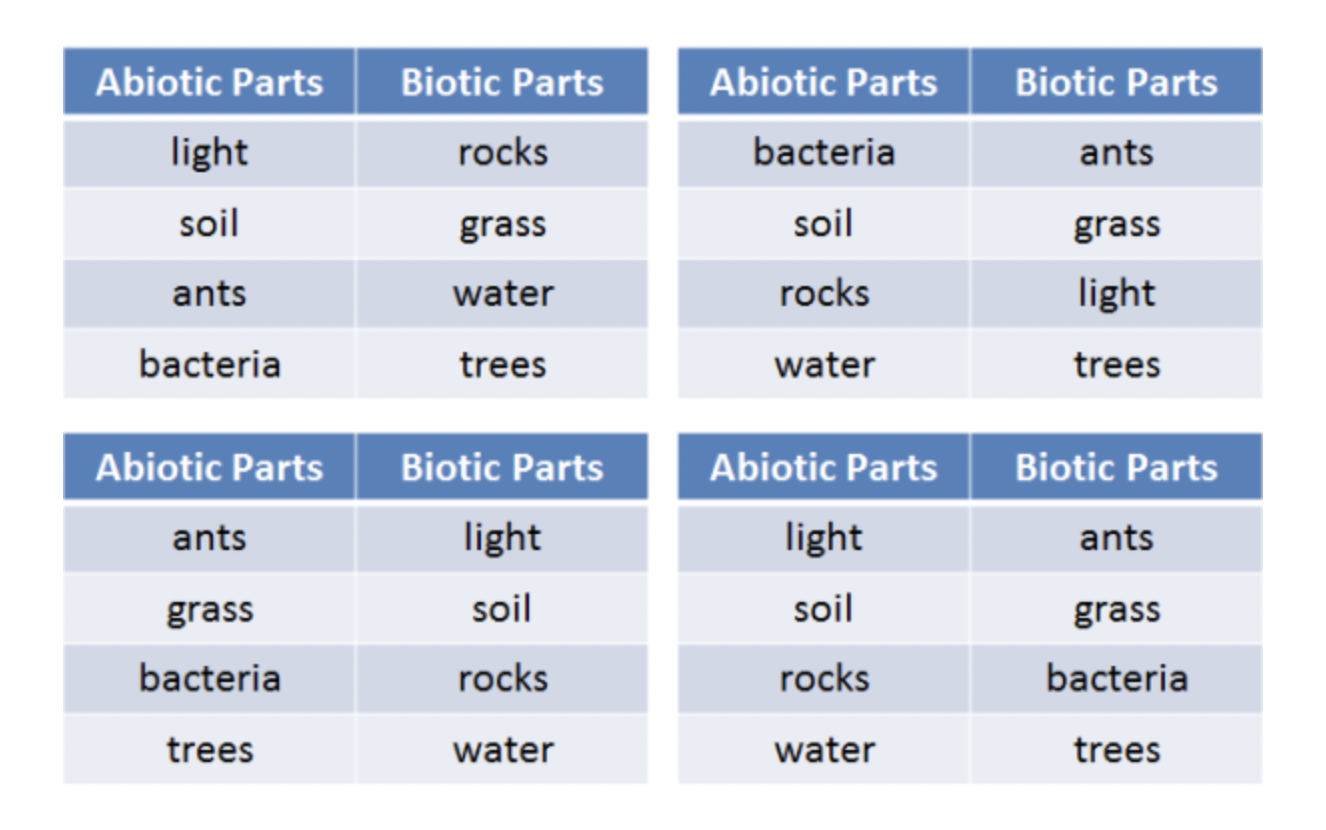
All ecosystems are made up of two basic types of factors—abiotic factors and biotic factors. The abiotic factors include all of the nonliving parts of the ecosystem. The biotic factors includes all of the living parts of the ecosystem.
Denise is studying an ecosystem at her local park. She makes a list of all the abiotic and biotic parts of the ecosystem. Which of the following lists would be correct for Denise's ecosystem
\
(photo)
Denise is studying an ecosystem at her local park. She makes a list of all the abiotic and biotic parts of the ecosystem. Which of the following lists would be correct for Denise's ecosystem
\
(photo)
Abiotic - light soil rocks water
Biotic - ants grass bacteria trees
Biotic - ants grass bacteria trees
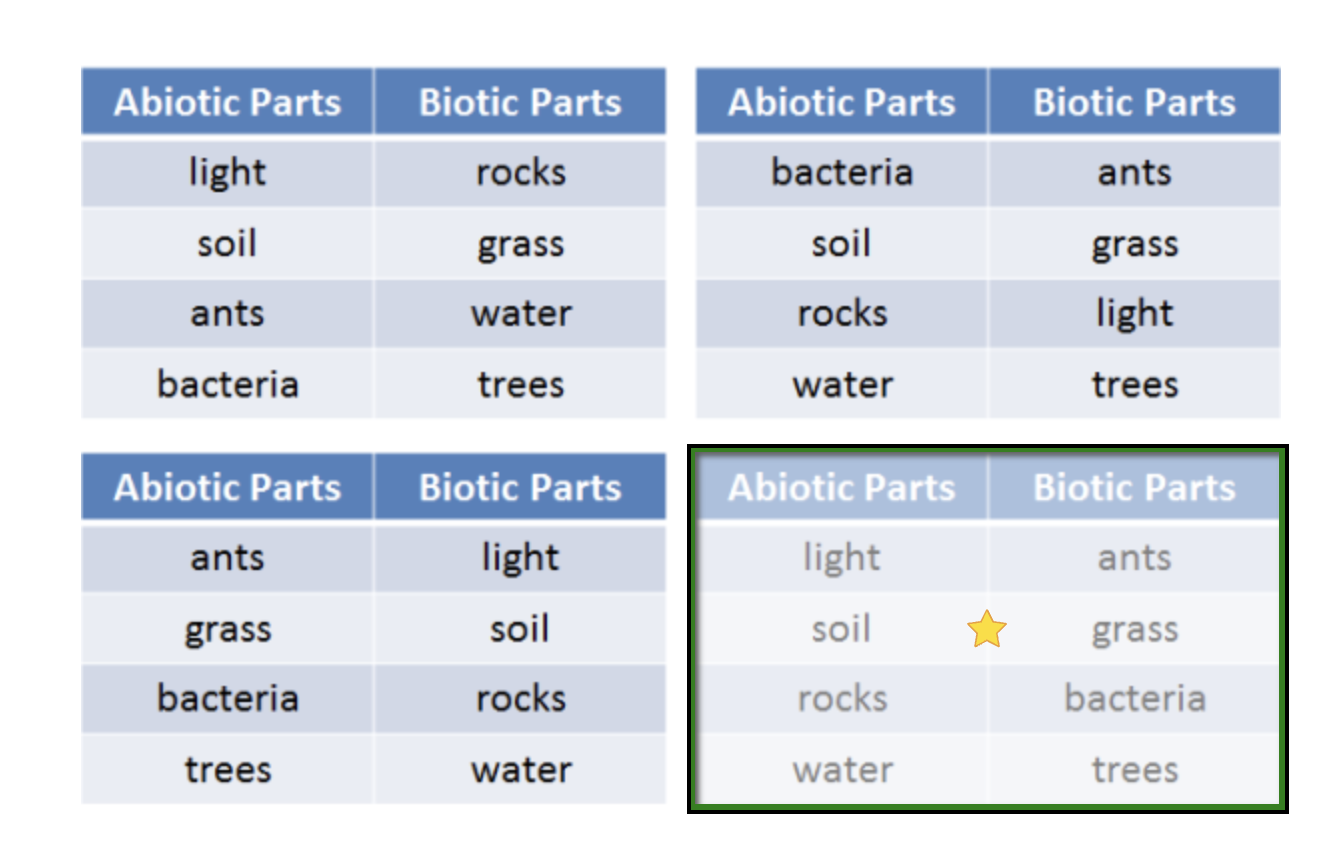
50
New cards
In a rainforest, a single howler monkey would be an example of
an organism
51
New cards
The Great Lakes region has both biotic and abiotic components. \n \n Abiotic components include water, temperature, rainfall, and geological features. Biotic components include all of the animal and plant species in the area. \n \n The ecosystem of the Great Lakes includes _______.
all of the biotic and abiotic components of the Great Lakes region
52
New cards

The map below shows some of the biomes present on the continent of Africa.
\
(photo)
\
Which of the following most likely describes the climate of Port Elizabeth?
\
(photo)
\
Which of the following most likely describes the climate of Port Elizabeth?
hot and dry
53
New cards
Which biome is dry, cold, and has frozen soil?
tundra
54
New cards
A community includes
all of the living organisms in a specific place at a specific time.
55
New cards
Choose the abiotic factors that best describe a coniferous forest.
adequate water, cool year round, poor rocky soil
56
New cards
The Great Lakes are home to many species of fish. Brook trout, freshwater drums, lake herring, largemouth bass, northern pike, and white perch are just a few of the species that can be found there. \n \n Which of the following is an example of a population of fish that can be found in the Great Lakes?
a group of freshwater drums spawning in the same area
57
New cards
Spider monkeys live in a biome with many trees. They move around by swinging from tree to tree. Spider monkeys do not build a nest or take shelter in a cave. Instead, they sleep high up in a tree on a wide branch. Spider monkeys mostly eat fruits and nuts. What type of biome do spider monkeys most likely live in?
tropical rainforest
58
New cards
Which of the following is an example of a population?
all of the western diamondback rattlesnakes in Big Bend National Park
59
New cards
Brian lives in a biome that is very similar to a grassland. Trees spot the landscape of this biome. This biome has seasonal rains and stays warm year-round. What kind of biome does Brian most likely live in?
savanna
60
New cards
Taiben went on a walk in the forest. He saw a deer grazing in the grass, a bird eating a berry, a fish swimming in a creek, and a fox catching a rabbit. \n \n _______ is an action that has both a biotic and an abiotic component involved. \n \n _______ is an action that involves only biotic components.
A fish swimming in a creek; a bird eating a berry
61
New cards
Which of the following involves only biotic factors?
a duck catching and eating a snail
62
New cards
Temperate deciduous forests are characterized by trees that lose their leaves in the winter. Which of the following is an abiotic factor found in temperate deciduous forests?
cold winter temperatures
63
New cards
A biologist is studying a biome that has very cold temperatures. A layer of this biome's soil stays frozen year-round. What biome is the biologist most likely studying?
tundra
64
New cards

Zebra mussels were introduced into the Great Lakes region in the 1960s. They are not a native species and they spread quickly throughout the area. Zebra mussels attach to other species of mussels and often kill them. They also use up resources that native mussel species depend on for survival. As a result, zebra mussels have almost completely gotten rid of native mussels in the Great Lakes region. \n \n Based on the table below, what type of interaction do the zebra mussels have with the native mussels?
community interaction
65
New cards
Which of the following ecological levels of organization includes abiotic factors?
ecosystem
66
New cards
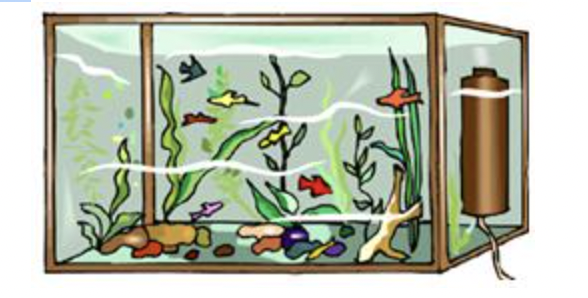
A fish tank is a type of human-made ecosystem.
\
(photo)
\
Which of the following lists only abiotic factors found in a fish tank ecosystem?
\
(photo)
\
Which of the following lists only abiotic factors found in a fish tank ecosystem?
water, oxygen, constant temperature
67
New cards
Fredrika's science teacher asked her to bring in three abiotic items from her backyard ecosystem. Which of the following groups of items should she bring?
a smooth rock, some red dirt, and an empty bird's nest
68
New cards
Choose the **biotic** factors that characterize the deciduous forest biome.
deer, maple trees, lichen
69
New cards
A particular species of lizard lives underground for much of the day, escaping the heat. This species of lizard probably lives in a _____.
desert
70
New cards
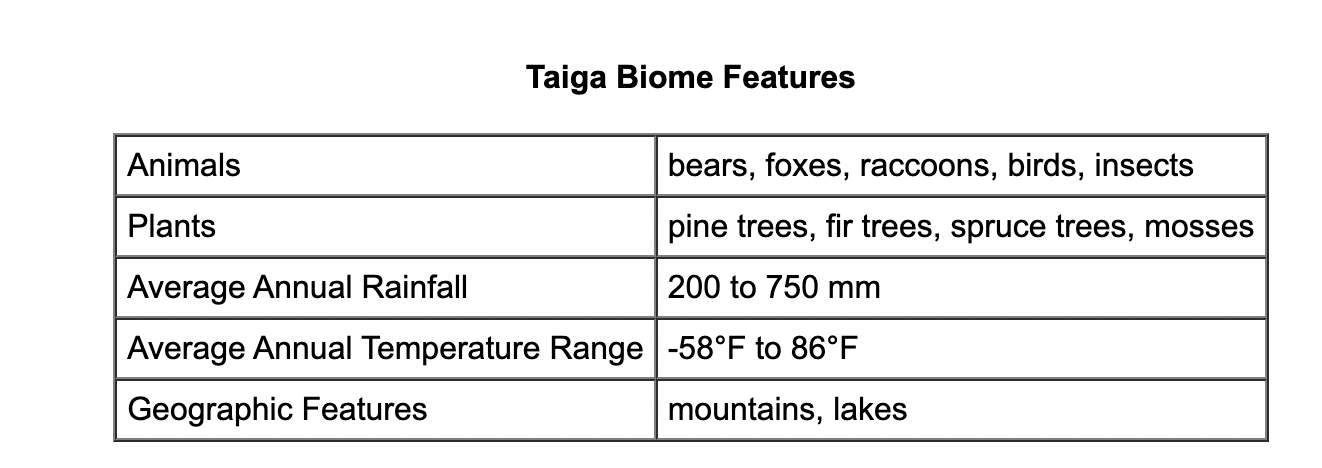
(photo)
\
The table above lists many features of an ecosystem in the taiga biome. Based on this table, what are the biotic features of the taiga?
\
The table above lists many features of an ecosystem in the taiga biome. Based on this table, what are the biotic features of the taiga?
bears, foxes, raccoons, birds, insects, pine trees, fir trees, spruce trees, mosses